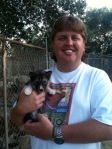The Iditarod Trail Race Checkpoints (Even Years)

The Iditarod is run every March starting in Anchorage and finishing in Nome, Alaska about 9-11 days later. The race alternates from a Northern Route (even numbered years) and a Southern Route (odd numbered years). This article describes the checkpoints on the 2010 race map.
- Anchorage: Population 260,283. The race began March 4, 2010 at 10 am on 4th Avenue.
- Willow Lake- Mile 69 Parks Highway: Population 1,838. The official race clock starts.
- Yenta Station: Population 8. A roadhouse-checkpoint in the Susitna Valley.
- Skwentna: Population 111. Located near the confluence of the Yetna and the Skwentna rivers.
- Finger Lake: Population 2. Kristen and Carl Dixon run this checkpoint on the eastern fringe of the the Alaska Range.
- Rainy Pass: Population 2. Rainy Pass Lodge on Puntilla Lake is at 1,800 feet elevation. Pass elevation is 3,1600 feet.
- Rohn Roadhouse: Population 0. This checkpoint is near the remains of one of the old roadhouses serving the historic Iditarod Trail mail carriers.
- Nikolai: Population 104. Ann Athabascan village located 40 air mils east of McGrath.
- McGrath: Population 423. At the confluence of the Kuskokwim and Takotna rivers, McGrath has a small, full service airport, stores and a and is the hub of the Iditarod School District. The first musher into this checkpoint gets the Spirit of Alaska Award from PenAir.
- Takotna: Population 50. This Athabascan village is one the favorite checkpoints and where many of the mushers take their 24-hour layover.
- Ophir: Population 0. A ghost town named for a nearby creek that supported placer mining. The name is a reference to the biblical Ophir thought to be the source of King Solomon’s gold.
- Cripple: Population 0. Same checkpoint as used by the Iron Dog snowmachine race, located at the Poorman Airstrip, close to the former gold rush boomtown of Poorman.
- Ruby: Population 190. Ruby developed as a supply point for gold prospectors. It was named after the red-colored stones found on the riverbank which were thought by prospectors to be rubies.
- Galena: Population 713. Originally a supply and trans-shipment point for lead-ore mines. Today Galena serves as the transportation and government and commercial center for the western Interior of Alaska.
- Nulato: Population 345. A center for missionary activity in the late 1800’s.
- Kaltag: Population 230. The home of Edgar Kalland, an orginal serum runner. The Iditarod Trail leaves the Yukon River here to wind up Old Woman Pass to the Bering Sea.
- Unalakleet: Population 747. Unalakleet has long been a major trade center as the terminus for the Kaltag Portage, an important winter travel route connection to the Yukon River. The first musher into Unalakleet gets $2,500 in gold from Wells Fargo Bank.
- Shaktoolik: Population 230. Just north of this wind-whipped Eskimo village, the trail leave land for the ice of the Northern Sound.
- Koyuk: Population 297. Koyuk marks the end of the long, treacherous sea ice travel across the Norton Sound.
- Elim: Population 318. The trail turns inland slightly near this Eskimo village to cross the low Kwiktalik.
- Golovin: Population 144. Back on the coast at Golovin, an Eskimo village, mushers face a short ice run over Golovin Bay. The rest of the race is over land.
- White Mountain: Population 203. An eight-hour layover is mandatory here to all the dogs to rest for the last push to Nome.
- Safety: Population 0. From here, the trail follows the shores of Norton Sound to Nome.
- Nome: Population 3,505. The race ends here under the burled arch on Font Street. Originally called Anvil City, after a nearby gold rich creek, it was once home to 30,000 miners.



